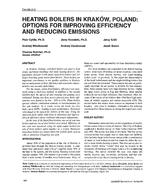To validate modeling tools used for the determination solar heat gain in complex fenestration (i.e., windows incorporating shade attachments), tests will be required on number of fenestration and shade combinations. One concern in this process, however, relates to tracking the sun, using the test calorimeter, in both azimuth and altitude. It is possible that the measured solar heat gain will change significantly with calorimeter tilt angle because convective flows are tilt depen-dent. While the calorimeter tilt angle will have no effect on the system optical properties, the inward-flowing fraction, which is dependent on convective flow around the shade, may change significantly. As such, a series of tests were conducted that examined changes in the inward-flowing fraction as a function of blind geometry and calorimeter tilt. Tests were performed indoors in a simulated wind field, using a calibration transfer standard as a mock window, with electrically heated blind slats. Tilt angles of 0 (vertical) to 75º were examined at 15º intervals, with an extra test at 85º. Slat angles of -45º, 0º, 45º, or 70º were also investigated. It was found that tilt angles greater than 60º affect the inward-flowing fraction. Previous results concerning slat angle were also confirmed.
Units: Dual
Citation: Symposium Papers, Atlanta, GA, 2001
Product Details
- Published:
- 2001
- Number of Pages:
- 7
- File Size:
- 1 file , 380 KB
- Product Code(s):
- D-7174


